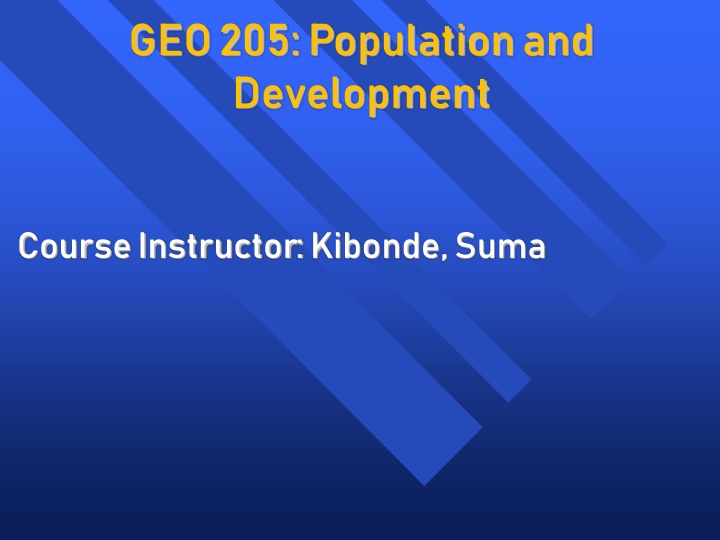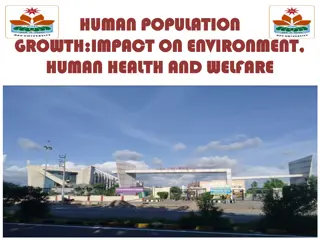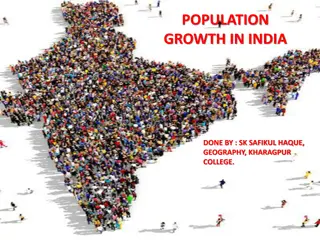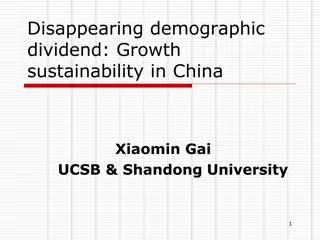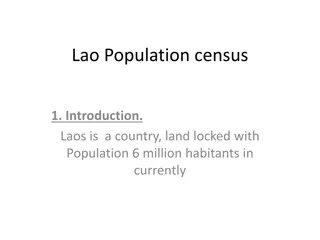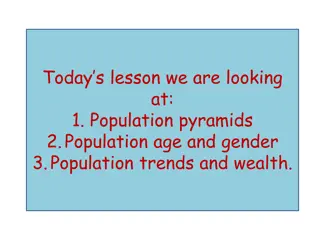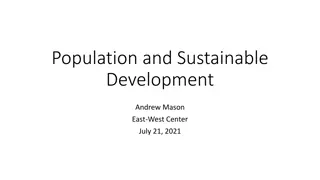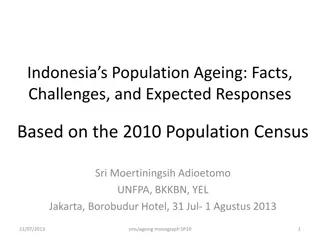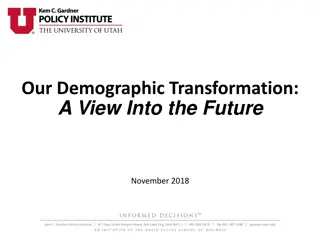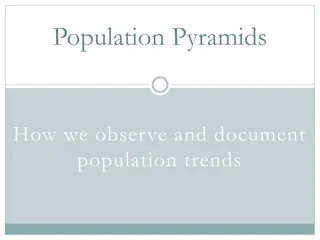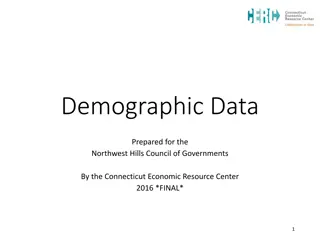Population and Development: Demographic Transition Model Analysis
This content explores the stages of the Demographic Transition Model (DTM) which illustrates how countries evolve over time in terms of birth rates, death rates, and population growth. The model delves into the historical context, causes of growth/shrinkage, and societal changes influencing population patterns. Emphasis is placed on the transitions from low growth to high growth, decreasing natural increase rate, and ultimately reaching low/no growth phases. Key factors driving these transitions include urbanization, cultural shifts, economic changes, and advancements in medicine and technology.
Download Presentation

Please find below an Image/Link to download the presentation.
The content on the website is provided AS IS for your information and personal use only. It may not be sold, licensed, or shared on other websites without obtaining consent from the author.If you encounter any issues during the download, it is possible that the publisher has removed the file from their server.
You are allowed to download the files provided on this website for personal or commercial use, subject to the condition that they are used lawfully. All files are the property of their respective owners.
The content on the website is provided AS IS for your information and personal use only. It may not be sold, licensed, or shared on other websites without obtaining consent from the author.
E N D
Presentation Transcript
GEO 205: Population and Development Course Instructor: Kibonde, Suma
RECAP: Demographic Transition Model Looking at how countries overtime change specifically focusing on birth rates, death rates and population growth Also the model looks at how countries grow/shrink, causes etc. Hence: Four stages, the fifth is still debatable
Stage 1: Low Growth Majority of human history took place in this stage There are no countries in this stage Everyone has progressed in the stage 2 Hunters and gatherers are in this stage Features: CBR is very high (lot of kids) CDR is very high (dying a lot- plagues) NIR is vey low
Stage 2: High Growth This stage first occurred after the industrial revolution (IR) 1750 With the diffusion of technology, medicine & medical revolution more countries joined stage 2 This happened after 1950 when penicillin, vaccines, insecticides and other medicines spread around the world Features: CBR still high CDR starts to decline NIR starts to boom
Penicillin, vaccines, insectides & other medicines diffused around the world after 1950 which lowered the CDR of many countries Cultural lag is when a culture takes time to catch up with technological innovation
Stage 3: Decreasing NIR During this stage the CBR starts to decline, the CDR continues to decline and our NIR is now moderate instead of high Why does this happen? Urbanisation Mind change (no more cultural lag) Economic changes make it harder to support a large family Improved medicine lower IMR
Stage 4: Low/No Growth CBR is low, CDR is low, NIR is low or ZPG (Zero Population Growth) Why? Urbanization continues Women have more roles/opportunities in society (no longer regarded as baby makers) Women who are more involved in the workforce have less time to have kids Women are more empowered A TFR of 2.1 is the replacement rate
Stage 5: Negative NIR (debatable) As the population ages the CBR remains low while the CDR starts to increase This causes a variety of problems for society Elderly support ratio: Number of pp aged 15-64 per one older person aged 65 or older Why high CDR? New diseases? Poverty? Countries are coming up with Family planning, Change policies e.g China
Determinants of DTT Psychological/emotional Society changes its rationale & opinion on f/size & parental energies redirected to qlty of child- raising Bio-physiological, infant mort & expectation of longer life in parents Socio-economic Childhood survival & ec challenges of large f/size
Demographic Rural urban migration shift from agr & labor-based prod output to techn & service-sector-based economies
Epidemiologic Transition Model (ETM) Distinctive cases of death in each stage of the demographic trans. Model It looks at the causes of death in society Is a branch of medical science concerned with the incidence, distribution and control of diseases that affect large numbers of people
Epidemiology Psychiatric Epidemiologists Diabetes Epidemiology Cardiovascular Epidemiology Cancer Epidemiology Infectious Disease Epidemiology
Mortality and Population Dynamics Proposition 1 The theory of epidemiologic transition begins with the major premise that mortality is a fundamental factor in population dynamics
Shifts in Mortality and Disease Patterns Proposition 2 During the transition, a long-term shift occurs in mortality and disease patterns whereby pandemics of infection are gradually degenerative and man-made diseases as the chief form of morbidity and primary cause of death displaced by Typically, mortality patterns distinguish three major successive stages of the epidemiologic transition
What is stage 1 of the ETM? Defined by Abel Omran in 1971 1. Known as stage of pestilence and famine characterized by: Infections, parasitic diseases, accidents, animal and human attacks were principal causes of human death T. Malthus called these natural checks on the growth of human population in stage 1 of the demographic transition model
Black death The Black Plague is stage 1 Example of disease diffusion said to have started in Kyrgyzstan brought by a Tatar army when it attacked an Italian trade outpost in present day Ukraine Retreating Italians brought the infected rats on their ships to other European coastal cities
What is in Stage 2? Called stage of receding pandemics (disease that occurs over a wide geographic area and affects a very high proportion of the population) I.E. Outbreak of cholera in crowded poor sanitized cities of the Industrial Rev. 1832: NYC lost 500,000 to cholera John Snow is known for mapping out and linking cholera source during a Great Britain outbreak to contaminated drinking water and showed that the poor were not being punished for their sins
Cholera was eradicated in the late 19th century however it reappeared a century later in growing cities of less developed countries as they moved into stage 2 of the DTM
What is Stage 3 & 4? Stage of degenerative diseases and human created diseases Characterized by a decrease in deaths from infectious diseases and an increase in chronic disorders associated with aging Two most important in this stage are heart disease (cardiovascular) and cancer
Stage 4 is an extension of stage 3 Delay of degenerative diseases because of operations, medicine, better/preventive diets, etc
Hybristic stage Rodgers & Hackenberg (1987) added this stage bcz original theory didn t consider deaths due to Violence and accidents Individual behaviors and potentially destructive behaviors. E.g. HIV/AIDS Physical inactivity, excessive drinking, unhealthy diet, cigarette smoking Liver cirrhosis, lung cancer, diabetes, heart diseases
Summary Age of Pestilence and Famine Age of Receding Pandemics The age of degenerative & man-made diseases Hybristic stage
Is there a Stage 5? Some argue that infectious and parasitic diseases are reemerging ; others just see it as a setback Reasons for this emergence: 1. Evolution- microbes are immune to antibiotics, 2. Poverty- disease like TB are largely controlled in countries like US but still causing many deaths in less-developed countries 3. Travel-disease diffusion (ex. SARS from China) (Severe acute respiratory syndrome)
Vocabulary: Chronic diseases: Infectious diseases: Genetic diseases:
Relative Risks of Mortality by Age and Sex Proposition 3 During the epidemiologic transition the most profound changes in health and disease patterns obtain among children and young women Genuine improvements in survivorship that occur with the recession of pandemics are peculiarly beneficial to children of both sexes and to females in the adolescent and reproductive ages Probably because the susceptibility of these groups to infectious and deficiency diseases is relatively high
Interacting Transition Variables Proposition 4 Shifts in health & disease patterns are closely accompanied with bio-physical, socioeconomic & psychological factors constituting modernization complex probability of infant/child survival prolonged lact lengthened mother's ppt period of natural protection against conception (Bio-physiological factors
As probab of child survival interest in having many children , social & economic system consider child as an economic liability rather than asset (socio-economic factor) As couples become aware that their children will survive, the likelihood of practicing family limitation is enhanced (Psychological factors)
Basic Models of the Epidemiologic Transition Proposition 5 Countries differ in level of ec dvt, demo variables and other aspects Differ in disease & health patterns & consequences on sociaties as countries pass thro ETT stages 4 models/variants of the ETT are proposed The Classical/Western Model The Accelerated Variant of the Classical Model The Delayed Model The Transition Variant of the Delayed Model
The Classical (Western) Model Gradual trans from high to low mortality and fertility Mortality: >30/1,000 to <10/1,000 Fertility: >40/1,000 to <20/1,000 Infect diseases displaced by deg & man-made diseases Late 18th C, lasted over 150 yrs to post-World War II era Fertility & mortality decline at almost the same rate
Modernization societies in 19thC England, Wales, Sweden, Germany in most western European
The Accelerated Variant of the Classical Model Rapid transition as a result of a few decades of intensive war-driven industrialization followed by postwar occupation The accelerated transition follows a pattern similar to the Classical/Western Model except that it occurs within a much shorter time span. Why? Selective improvement in survival of children <15 and of women Improvement in sanitation, nutrition & medical advance
Shift to the age of degenerative and man-made diseases was much faster Observed in Japan, China, Eastern Europe
The Contemporary/Delayed Model Relatively recent, yet-to-be completed, lasting into 21st C Most d ping countries due to slow ec dvt Medical and public health improvements have reduced mortality, while the birth rate continues to remain high Although these programs have successfully manipulated mortality downward but have left fertility at substantially high levels ex. Mauritius
The Transition Variant of the Delayed Model Transition in a number of developing countries such as Taiwan , Singapore, South Korea, Sri Lanka, Mauritius, Jamaica, China e.t.c Rapid decline in mortality in these countries was comparable to that in countries matching the delayed model
Importance of Geographic Patterns
Incidence of Stomach CA Males Japan Columbia Iceland Finland UK US NW US White India Nigeria 0 20 40 60 80 100
Breast Cancer Incidence Females US Whites US NW UK Poland Jamaica Singapore Brazil Nigeria Japan 0 5 10 15 20 25 30
CHD Death Rates Males, aged 45-54 Finland Scotland UK US Bulgaria Italy Egypt Japan Guatamala Thailand 0 500 1000 1500
Cirrhosis Death Rates, Males, aged 45-54 France Italy Japan US Hong Kong Scotland UK 0 10 20 30 40 50 60 70 80 90
High Incidence of NCDs in Developing Countries Possible Infectious Etiology Macronodular Cirrhosis Hepatocellular Carcinoma Rheumatic Heart Disease Iron deficiency anemia Related to Nutrition Deficiency Endemic Goiter Malnutrition Related Diabetes.
High Incidence of NCDs in Developed Countries Cardiovascular CHD Deep Vein Thrombosis Respiratory Emphysema Lung CA Female Genital Endometriosis Endometrial CA Breast Breast CA Fibrocystic Disease Male Genital Prostrate CA Metabolic NIDDM
Back to Nature Improved Physical activity A Healthier Diet, less saturated fats, more fiber Less Stress
Transition Nomads Farmers Urban 45 yrs 60 yrs 70 yrs
1960 Urban Rural rural urban Developing Countries USA
2006 Urban Rural urban rural Developing Countries USA
Causes of Death Developed Developing Age 15-44 Accidents CA CHD Age 45-54 CHD CA Accidents Age 15-44 Accidents CHD CA Age 45-54 CHD CA Accidents
Conclusion This theory gives theoretical perspective to the process of population change by relating mortality patterns to demographic and socio-economic determinants and consequences of health and disease changes in a variety of social contexts
